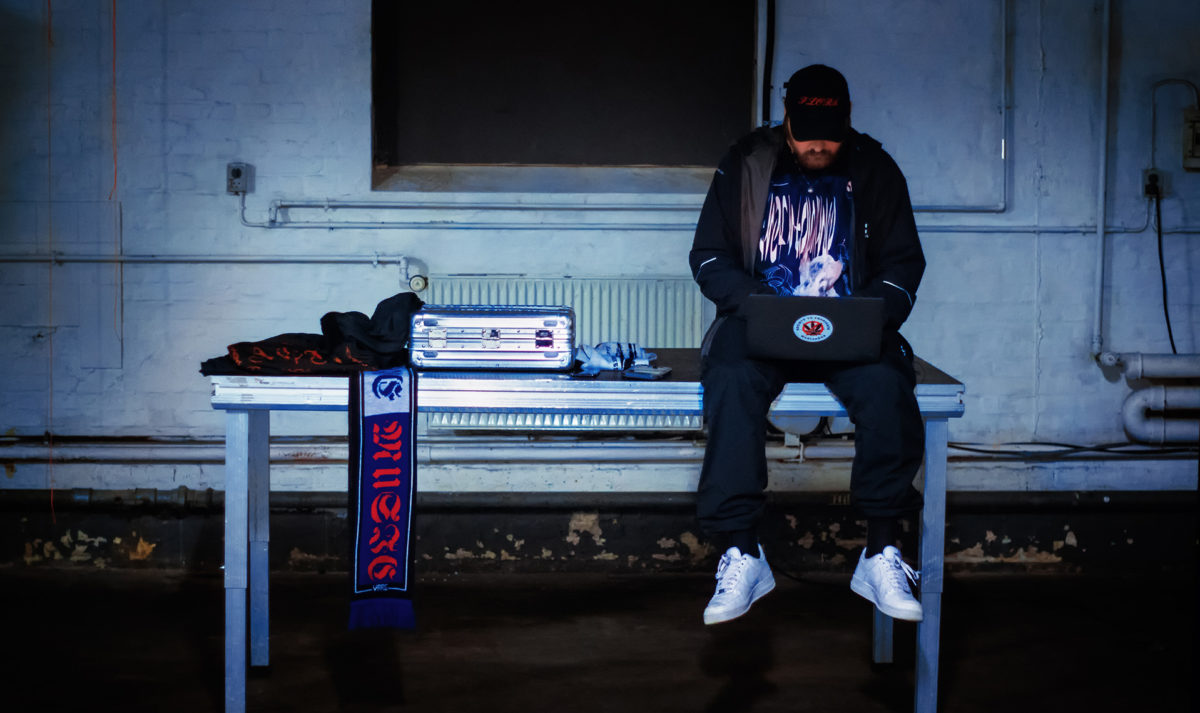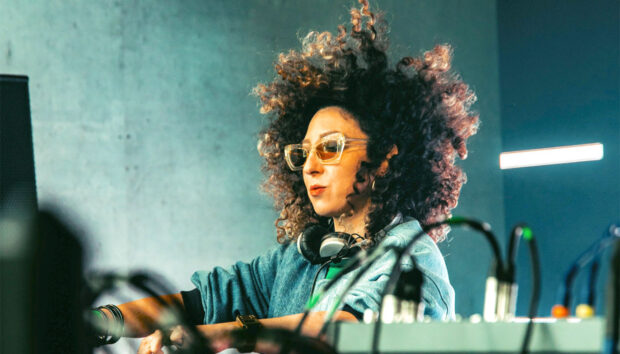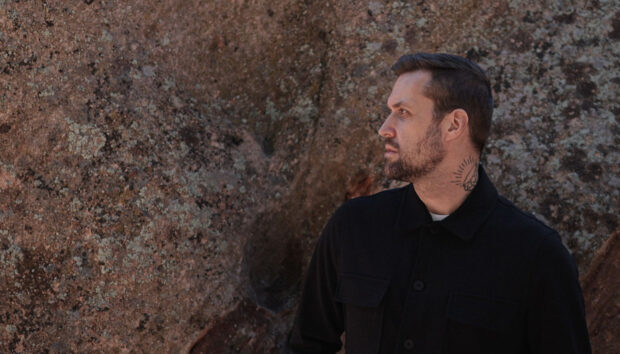“Varg is just me. I don’t know what else I should say — I don’t try to intellectualize it”. Varg —which in Swedish means wolf— was the nickname given to Jonas Rönnberg when he was a child. Since then, the handle has transformed itself into an entire operation, going on to build a discography spanning more than seventeen records.
Besides producing tongue-in-cheek techno under his solo moniker Varg, Rönnberg performs alongside punk-techno trio The Empire Line and produces lullaby-like experimental and ambient via the all-encompassing art project FLORA. Moreover, together with Abdula Rashim, Rönnberg co-runs Northern Electronics, the Stockholm-based label that is campaigning for total sonic disruption within the contemporary Nordic electronic music scene and beyond.
Rönnberg is no stranger to the functionality of analog hardware — it’s with MIDI that the unfamiliarity lies. On a mission to further his sound through digitisation, Rönnberg has recently enlisted the help of REAKTOR and more widely KOMPLETE to tap into new and compelling modes of production that reflect his many musical identities. His last feature-heavy record Evanescence (A Love Letter) is the culmination of those recent technical musings and orchestrates the beginning of an outlandish artistic breakthrough.

Dubstep, and drum and bass were the first styles of electronic music that you discovered through listening to London-based radio station Rinse FM, which, as of last year you are now a resident of. What led you to start producing ambient, experimental and techno?
When I was 16, I used to make all sorts of UK inspired music; that’s where I began. I dropped an untitled vinyl release in 2011 that was along the lines of dubstep which I’d made with MASSIVE, a flute, an acoustic guitar, and Fruity Loops. At that time I was also going to a lot of raves and started to hear more techno and experimental music. I heard it, it touched my ears, and I guess it stuck with me. I wanted to start making music properly, so I bought some gear. I never reflected on it; it just came out of me. Those were the sounds that were appealing to me and that I managed to create.
In February you released your latest project Evanescence (A Love Letter) via Copenhagen-based experimental label Posh Isolation. Besides your experience with MASSIVE, this is the first release that you really embraced the use of KOMPLETE during your production process.
Yeah, it was. The opening song ‘Love Letter (Sky City, Introduction)’ is the first ever track I properly used Native software on. It’s very much an insight into my exploration of MIDI and how I was learning to control these programs. It’s quite a weird track which I don’t think I would be able to recreate now.
Since this project, I’ve been hooked on REAKTOR, and it definitely changed my workflow. Now I mainly produce with my laptop because that’s what sounds best and what I can get the most frequency range out of. Since making that track and learning how to control MIDI clips there’s been no turning back. I’m a laptop warrior now!
So this was a release that you experimented a lot with REAKTOR?
The track I did with Coucou Chloe called ‘I Get Lit (cause if not, I think of u)‘ was made entirely with synth Blocks from REAKTOR and was the first track where I felt like I was starting to gain control. ‘Love Letter (Sky City, Introduction)’ was a track where I had no idea what I was doing, and this track [I get lit] is where I started to feel safe and reached a point of understanding.
When making ‘Wear it (100.000 petals fell like rain)‘ I sat down and really tried to control my use of KOMPLETE. It’s basically a bunch of layers of KONTAKT, MASSIVE and REAKTOR synths. If you listen to the track, it might sound controlled, but it was very much out of control at the time. I had a hard time getting it to work in the way I wanted it to because MIDI and I are still getting to know each other. But in the end, this was the track that opened the door, and I thought wow, these synths sound great!
To make this track, I Initially downloaded an existing MIDI clip, put it into Ableton and extracted a loop that I liked. That’s something that I do a lot, I take a track that I like, and I put the MIDI from that track into Ableton to get inspiration from those sounds. After that, I made fifteen layers of the same melody. I used seven channels of REAKTOR, seven channels of KONTAKT and then I employed different presets on every channel. Next, I make compositions with layers of the same melody. If you listen to ‘Wear it (100.000 petals fell like rain)’, the kick drum is the same MIDI mapping as all the melodies, and then I have LFOs control the different attacks. So it sounds like different melodies, but it’s actually just the same one. When I’m happy with the way it sounds, I take away the MIDI clip that I first inserted and create a melody myself.
You’re still getting acquainted with MIDI, and it seems that the KOMPLETE KONTROL S49 has been helping you in doing so?
I’m still learning how to use MIDI. I was always fascinated by it in the same way a lot of people are fascinated by analog hardware. I’ve fooled myself into thinking that using the S49 is like using a piece of hardware; a piece of hardware that makes my whole process of producing a lot easier. I’ve been using it to record MIDI clips and loops. I never learned to play keys, so when I record, I’m playing around until I find something I like. Previously I’d record using the Roland Juno- 106 and even if I found a good loop I couldn’t alter the recorded sound. The S49 makes it super simple to move around the notes and make it perfect, remarkably tight and slick. Then I’m completely happy with it.
With the S49 I map the MIDI keys for the whole track, so 5-6 minutes of audio and then I do another take where I record all the MIDI to an audio channel where I adjust the filters accordingly. The keyboard works exceptionally well with REAKTOR because it’s all so well integrated. The synths come alive in a totally different way. I finally feel liberated to experiment with KOMPLETE in the same tactile way that I’d approach using my other gear.
Around a year or so ago I saw that you were trying to sell off your entire collection of hardware?
I became anxious about my process of making music and wanted to sell everything, but in the end, I sold a few pieces and put the rest in storage. I realised that if I were to go through with it and sell it all off that I would regret it and have difficulty with getting everything back again.
How often do you visit the storage space to return a piece of hardware and exchange it for something new to add to your rotating setup?
I visit the storage space to collect something every three months, if that. My main home setup includes the MOOG DFAM drum machine, the EDP Wasp synthesizer, my laptop with KOMPLETE and the S49.
Right now you don’t have a studio, and you prefer to produce when you’re on the road anyway. Whether it’s on a plane, a train or sitting down in your hotel room for a moment before or after a show: what’s your setup for producing while you’re on tour?
I don’t need a studio in that sense. Of course, it’s nice to have monitors. At the moment, when I‘m on the road, I’m producing with the Erica Synths techno-system drum machine together with REAKTOR. I’ve really enjoyed using the Erica Techno System to make all the drums and then making all the synths with REAKTOR. The Erica modular has such a tight clock, so I don’t even have to sync it from my computer. I just input the BPM into the sequencer. It’s surprisingly very compatible with REAKTOR.

How do you utilize KOMPLETE during your live performance?
When it comes to my live performance, I have Ableton set up with all of my pre-recorded loops. I simultaneously employ the bitcrusher BITE and use the DRIVER distortion filter on almost everything. Additionally, I use the SOLID BUS COMP compressor on my master channel and then line-in the Erica Synths Techno-System. LAZER DICE is what I use a lot when it comes to controlling the bass in my live performance through mapping it to different MIDI clips. I use the built-in sound generators a lot too. I have a couple of presets that I really like. I know which patch to use specifically, but I never sat down and tried to learn how it works, so whenever I use it it’s somewhat random, and I prefer that changeability.
Playing in a lot of different spaces I’ve found that the kick can sound great on one system and on another, the frequencies won’t cut through that specific system. When I played at Berghain in February, I noticed this issue during the soundcheck and while I was at the venue, I tuned all my drums in REAKTOR to suit their specific system. Afterwards, I went back to my hotel and remade all of my tracks. That was possible. It took three hours, but I was able to make everything sound as impressive as possible for that particular space.

How has the sound of Varg evolved over the last six years as your studio workflow has transformed?
I’m able to put more detail into my work now that I have access to so many different instruments. I can have one 303-acid bassline layered with the same MIDI files as a cello from the cinematic SESSION STRINGS PRO, and it sounds incredible. Tapping into the creative freedom of layering is so effortless. The unlimited presets are what inspires me. I have no idea what’s going to happen when I sit down and start to experiment. For me, it’s revolutionary to learn how to use my computer in this way. I know its 2019 and I might sound like an idiot, but I honestly didn’t know things like this were possible. I never explored it more or saw how I could make the tools my own. But now I see the freedom in it. I can make music wherever and whenever. I pick up my laptop, and I’m ready to go with sounds that are truly my own.
What’s next for Varg?
I have two solo Sky City EPs coming out via Northern Electronics on May 3, as well as a Varg and Croatian Amor collaborative record which is out in the summer and will be the follow up to our Body of Water release from 2018. All three were made purely with Native Instruments synths.
photos: Yvonne Hartmann


















